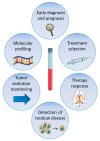Liquid Biopsy in Glioblastoma: Opportunities, Applications and Challenges
- PMID: 31284524
- PMCID: PMC6679205
- DOI: 10.3390/cancers11070950
Liquid Biopsy in Glioblastoma: Opportunities, Applications and Challenges
Abstract
Liquid biopsy represents a minimally invasive procedure that can provide similar information from body fluids to what is usually obtained from a tissue biopsy sample. Its implementation in the clinical setting might significantly renew the field of medical oncology, facilitating the introduction of the concepts of precision medicine and patient-tailored therapies. These advances may be useful in the diagnosis of brain tumors that currently require surgery for tissue collection, or to perform genetic tumor profiling for disease classification and guidance of therapy. In this review, we will summarize the most recent advances and putative applications of liquid biopsy in glioblastoma, the most common and malignant adult brain tumor. Moreover, we will discuss the remaining challenges and hurdles in terms of technology and biology for its clinical application.
Keywords: Liquid biopsy; ctDNA; glioblastoma.
Conflict of interest statement
The authors declare no conflict of interest.
Figures


References
-
- Louis D.N., Perry A., Reifenberger G., von Deimling A., Figarella-Branger D., Cavenee W.K., Ohgaki H., Wiestler O.D., Kleihues P., Ellison D.W. The 2016 World Health Organization Classification of Tumors of the Central Nervous System: A summary. Acta Neuropathol. 2016;131:803–820. doi: 10.1007/s00401-016-1545-1. - DOI - PubMed
-
- Stupp R., Hegi M.E., Mason W.P., van den Bent M.J., Taphoorn M.J., Janzer R.C., Ludwin S.K., Allgeier A., Fisher B., Belanger K., et al. Effects of radiotherapy with concomitant and adjuvant temozolomide versus radiotherapy alone on survival in glioblastoma in a randomised phase III study: 5-year analysis of the EORTC-NCIC trial. Lancet Oncol. 2009;10:459–466. doi: 10.1016/S1470-2045(09)70025-7. - DOI - PubMed
Publication types
Grants and funding
LinkOut - more resources
Full Text Sources

